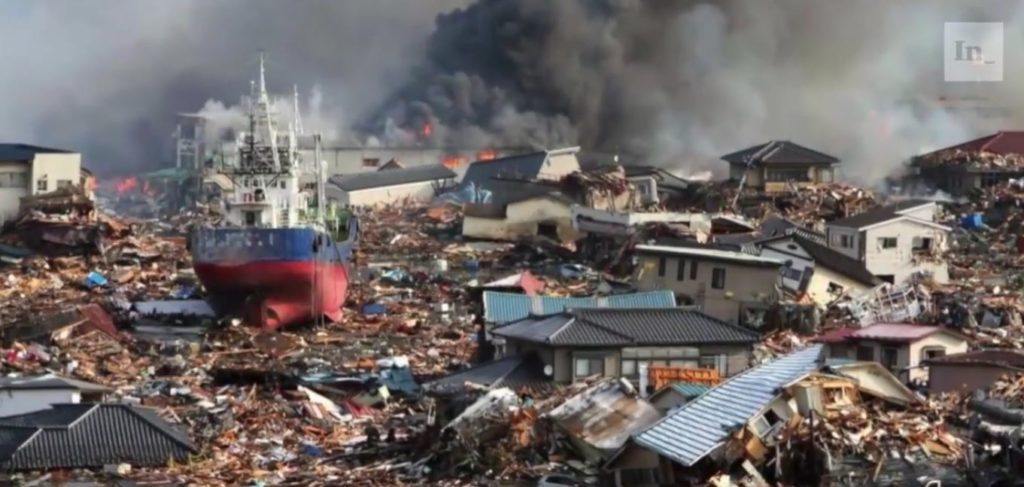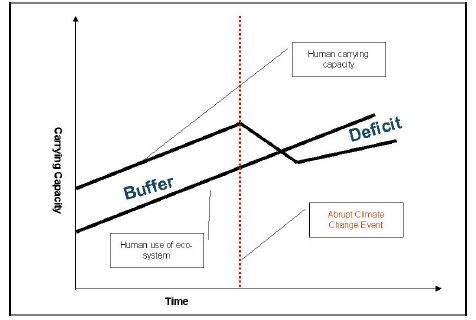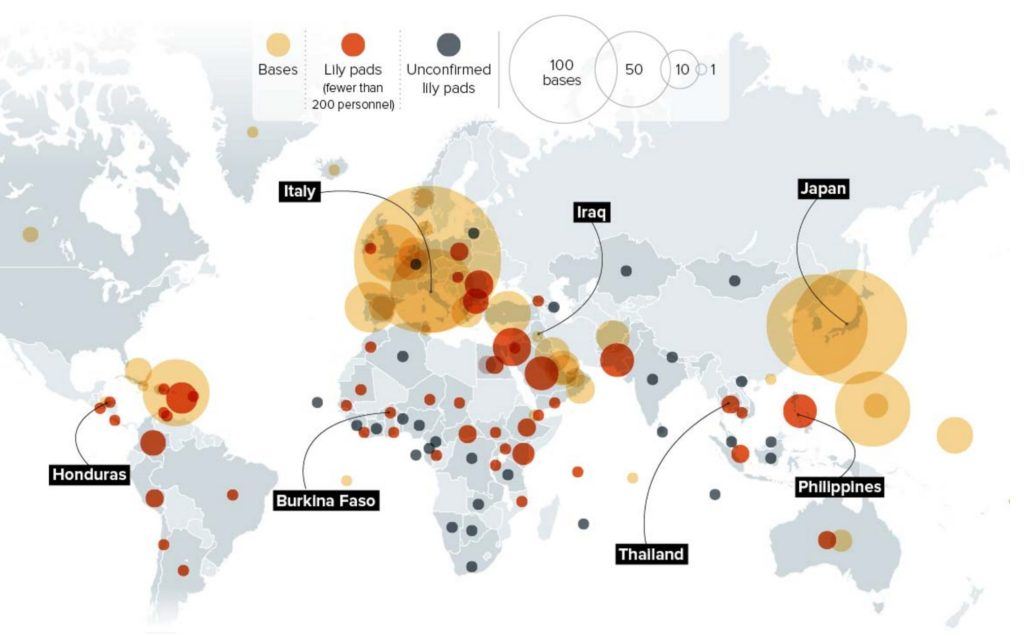‘Mother of All Risks’: Climate Change and the U.S. Armed Forces

At the Pentagon, there is growing consensus that military leaders must innovate to meet the threats posed by climate change head-on
On October 13th, The Intercept posted a chilling video obtained from the Pentagon via the Freedom of Information Act. Shown in training courses at Joint Special Operations University, the short film portrays the world’s cities of 2030 as sprawling labyrinths that are crumbling due to overpopulation and economic inequality, exacerbated by the compounding forces of global climate change. “This is the world of our future,” the video’s narrator states. “It is one we are not prepared to operate effectively in. And it is unavoidable.” [1, 2]

Though the video has been chided by some as overly bearish and sensational, its existence signals that senior leaders in the Department of Defense and US Armed Forces are coming to realize — even as politicians remain divided on the issue — that climate change presents an absolute and inalienable risk that must be taken seriously [3, 4].
Connecting the dots
As early as 2003, the Pentagon Office of Net Assessments began exploring the potential need for a contingency plan addressing an abrupt global climate change scenario. CalTech’s Jet Propulsion Laboratory at Pasadena responded with a 23-page report arguing that the risk should be elevated “beyond a scientific debate to a U.S. national security concern.” Authors Peter Schwartz and Doug Randall found continued warming could result in a rapid fall in the planet’s human carrying capacity, setting the conditions for mass competition, an upheaval of the global political order, and the ensuing outbreak of widespread conflict [5].

Even if such an extreme scenario might be avoided, scientists have found strong causal evidence linking the myriad adverse effects of climate change to rising levels instability and violence across geographies. One recent study found that the frequency of intergroup conflict rises 14% for each standard deviation (1σ) change in temperature — a disturbing conclusion, as scientific consensus projects warming of 2σ to 4σ over the next 30 years [6, 7].
Foreseeable challenges
A changing climate is not just likely to drive higher demand for the forceful resolution of conflict, but will also complicate the military’s operational procedures and threaten its worldwide network of assets. Special operations forces and other combat arms units will have to spend more time training for defense support to civil authorities (DSCA) missions and noncombatant evacuation operations (NEOs), while simultaneously maintaining proficiency across their traditional mission profiles. National Guard units must also prepare to provide competent disaster relief and civil support services despite limited budgets and training resources.
At the same time, climate change puts countless US military installations at risk, including bases within America as well as 800-plus others around the globe. The financial value of simply maintaining these facilities under current conditions weighs in at over $85 billion per year [8]. The majority of these bases and ports are coastal installations that are predictably vulnerable to rising sea levels. The costs of retaining the American military empire as it currently exists could grow astronomically in the coming years, complicating US efforts to project military power around the globe.

Finally, the potential impact on the military’s acquisition and supply chain requirements is obvious. Economic and resource disruptions will not only create difficulties for the production of additional military equipment in a time of need, but would also limit the ability of all services to fuel and power their vehicles, ships, planes, and bases.
The way forward
Fortunately, various departments within the US Government have at last come to focus on this emerging threat. In December 2012, the Department of Defense established a Climate Change Adaptation Working Group (CCAWG) in response to Executive Orders 13514 and 13653 [9]. In 2014 the DoD published a comprehensive set of reports and policy letters, including the Climate Change Adaptation Roadmap and the 2014 Quadrennial Defense Review [10, 11].
Department Secretaries, the Joint Chiefs, and Combatant Commanders must now execute on the first official directive from the Pentagon [12]. The greatest danger is that slow planning cycles will delay the start of implementation processes requiring years of aggressive and sustained effort. Planners should modify their long-term forecasts now to account for a global order and physical landscape that may severely restrict the military’s current freedom of maneuver and economic access. To reduce the risk of systemic shock, models should prioritize diversity in equipment and power sources, as well as modularity in the design of facility and infrastructure networks. Early efforts to draw more energy from sustainable sources must receive greater attention from top brass, as current over-reliance on non-renewable sources exposes the military services to heightened risk [13]. Most importantly, field-grade officers throughout the services should be encouraged to act on their own bottom-up analysis.
A changing climate presents looming challenges to global stability and US national security in the years ahead. If it takes bold action now, the military can ensure it is ready to face our world of tomorrow.
[wc: 794]
[1] Joint Special Operations University (JSOU) offers numerous courses ranging from days to months for US and international military students. Most classes are intended to train officers and non-commissioned officers to work in staff assignments within US Special Operations Command (SOCOM). JSOU’s public website can be accessed at [https://jsou.socom.mil/Pages/Default.aspx].
[2] Nick Turse, “Pentagon video warns of ‘unavoidable’ dystopian future for the world’s biggest cities,” The Intercept, 13 Oct 2016. Online: accessed Nov 2016 at [http://theintercept.com/2016/10/13/pentagon-video-warns-of-unavoidable-dystopian-future-for-worlds-biggest-cities/].
[3] Annalee Newitz, “Bizarre leaked Pentagon video is a science fiction story about the future of cities,” Ars Technica, 28 Oct 2016. Online: accessed Nov 2016 at [http://arstechnica.com/tech-policy/2016/10/bizarre-leaked-pentagon-video-is-a-science-fiction-story-about-the-future-of-cities/].
[4] Even Lehmann, “Republic platform rejects Paris Climate Agreement,” Scientific American, 19 July 2016. Online: accessed Nov 2016 at [https://www.scientificamerican.com/article/republican-platform-rejects-paris-climate-agreement/].
[5] Peter Schwartz and Doug Randall, “An Abrupt Climate Change Scenario and its Implications for United States National Security,” Pentagon Office of Net Assessments, October 2003. Online: accessed Nov 2016 at [http://oai.dtic.mil/oai/oai?verb=getRecord&metadataPrefix=html&identifier=ADA469325].
[6] The range of 2-to-4 standard deviations includes projections for nearly all regions and locations in the world; specific locations are expected to land within different parts of the band.
[7] Salomon Hsiang, Marshall Burke, and Edward Miguel, “Quantifying the Influence of Climate on Human Conflict,” Science, Vol. 341 Iss. 6151, 13 Sep 2013. Online: accessed Nov 2016 at [http://science.sciencemag.org/content/341/6151/1235367].
[8] David Vine, “Where in the world is the US military?” Politico, August 2015. Online: accessed Nov 2016 at [http://www.politico.com/magazine/story/2015/06/us-military-bases-around-the-world-119321].
[9] Executive Orders [EOs] are legally binding orders issued by the President to Federal Administrative Agencies. EO 13514 and 13653 dictated that each Department and Agency evaluate the impact of climate change on their mission and operations, and begin developing a plan of action to confront all identified challenges.
[10] “2014 Climate Change Adaptation Roadmap,” US Department of Defense, FY 2014. Online: accessed Nov 2016 at [http://ppec.asme.org/wp-content/uploads/2014/10/CCARprint.pdf].
[11] “2014 Quadrennial Defense Review,” US Department of Defense, FY 2014. Online: accessed Nov 2016 at [http://archive.defense.gov/pubs/2014_Quadrennial_Defense_Review.pdf].
[12] DoD Directive 4715.21, “Climate Change Adaptation and Resilience,” effective 14 Jan 2016. Online: accessed Nov 2016 at [http://www.defense.gov/Portals/1/Documents/pubs/471521p.pdf].
[13] Camille von Kaenel, “Energy security drives U.S. military to renewables,” Scientific American, 16 Mar 2016. Online: accessed Nov 2016 at [https://www.scientificamerican.com/article/energy-security-drives-u-s-military-to-renewables/].
Additional reading:
“The National Security Implications of a Changing Climate,” The White House of the United States, May 2015. Online: accessed Nov 2016 at [https://www.whitehouse.gov/sites/default/files/docs/National_Security_Implications_of_Changing_Climate_Final_051915.pdf].
Marshall Burke, Solomon Hsiang, and Edward Miguel, “Climate and Conflict,” Annual Review of Economics, Vol. 7: 577-617, Aug 2015. Online: accessed Nov 2016 at [http://www.annualreviews.org/doi/10.1146/annurev-economics-080614-115430].
Herbert Carmen, Christine Parthemore, and Will Rogers, “Broadening Horizons: Climate Change and the U.S. Armed Forces,” Center for a New American Security, April 2010. Online: accessed Nov 2016 at [https://s3.amazonaws.com/files.cnas.org/documents/CNAS_Broadening-Horizons_Carmen-Parthemore-Rogers.pdf].




It seems as though the military has defined plans regarding infrastructure, supply chain, and training, but it doesn’t have much to say regarding the tactical dilemma posed in the “megacities” video. As cities become increasingly complex with increasing populations, the difficulty of conducting tactical operations will increase exponentially.
Further, if this threat of climate change toward our global resources is realized, and we do see the increase in global instability coupled with higher costs of force projection, it seems like the scales quickly start tipping toward a no-win scenario. If the challenges posed in this article actually become a reality, the current plans outlined by the DOD will be vastly inadequate, as costs would simply be too high to maintain our current level of global presence. I would argue that the majority of our operations would then be centered along Base Realignment and Closure as we drastically reduce our international presence.
While I agree with BAH that climate change/megacities will challenge DoD operational planners and further strain budgets, I’m skeptical that this will lead to base closures and a reduced global presence.
On the contrary, if the U.S. government takes these challenges seriously, I suspect they will seek to expand DoD’s overseas presence through partnerships with allied governments in/near high-risk areas. I could easily imagine small footprint organizations (eg, crisis action teams) located inside foreign bases capable focused on building host-nation capabilities and planning for contingencies that require scaled operations.
I was part of such an organization in the southern Philippines (JSOTF-P). On a day-to-day basis, our 100-person team was focused on counterterrorism operations, but our larger mission was dedicated to improving the capabilities of the Philippine Armed Forces and building the relationships that we would need to rely on in the event of a large-scale contingency. One of the assets dedicated to this mission was the USNS Stockham, a roll on/roll off, maritime prepositioning force container ship stuffed to the gills with heavy equipment capable of supporting a Marine Air/Ground Task Force for 30 days. By DoD standards, assets like these are cheap and flexible, and could be extremely useful for the types of contingencies that climate change is likely to trigger.
To me, the real problem the Pentagon brass faces is whether or not it is willing to prioritize preparing for these types of contingencies. For the past century (and especially since the Cold War), DoD planners have viewed conflict primarily as a technological arms race between conventional belligerents–a view that becomes manifest in our defense budgets. Climate change seems to be pushing the DoD towards a future of humanitarian assistance/disaster relief missions and low-intensity conflict in urban environments, but the Pentagon brass still seems focused on programs like the joint strike fighter and the littoral combat ship that will prove of little use in those environments. Unless and until our spending priorities begin to align with the kinds of contingencies outlined in “Megacities” and “Global Trends 2030,” DoD will remain ill-equipped to meet the challenges of the 21st century.
https://www.dni.gov/files/documents/GlobalTrends_2030.pdf
http://www.msc.navy.mil/inventory/ships.asp?ship=160
Thanks for the interesting article, Chris! After reading your article, I’m wondering if the global warming trend would actually help the US military. Now that the US is the world’s largest producer of petroleum products, and given the prevalence of their nuclear-powered aircraft carriers, I’m wondering if the negative impacts of climate change would further solidify the US military’s dominance – especially at sea. Perhaps it is enough to rely on their current strong position globally to adapt better than adversaries, rather than try to build capabilities for a problem they are not yet facing. I liked the article, and the novel approach to an old issue. Good work!
In 2012 I was heartened to see the DoD recognize climate change as a risk to both U.S. military infrastructure (in the U.S. and abroad), and as a likely root cause of future wars and humanitarian disasters. However, I’m not sure what this recognition really means for the U.S. military.
For example, the U.S. Navy maintains the biggest Navy base in the world in Norfolk, Virginia, a city identified by scientists as extremely vulnerable to even minor rises in sea levels. The problem is bad and getting worse – high tides combined with one inch of rain were enough to leave six or more inches of water in the streets when I lived in Norfolk in 2014. That said, there is nothing the U.S. Navy can really “do” about the problem. The base is located where the base is located – the U.S. Navy cannot realistically move it. Slowing climate change and mitigating its effects is arguably the job of other branches of the U.S. government.
For their part, the Marine Corps and other expeditionary forces of the U.S. military have doubled down on training for Humanitarian Assistance, Disaster Relief, Non-Combat Evacuation Operation (NEO), and other non-kinetic operations likely to be caused by extreme weather events or resource crisis linked to climate change.
Great post Chris!
Given the very real implications of climate change for the military and the direct resulting risks to US national security, the actions you have outlined above, both those already being executed and those you recommend, seem like no regrets moves. I am left concerned however, given that funding for these activities is, at the end of the day, approved by political bodies (i.e., our executive and legislative branches). While the past 8 years have provided runway for the needs identification and initial project launch of climate change initiatives by DoD, is there a serious risk that future initiatives will not be able to get funded/ off the ground if Republicans control the Exec/ Legislative branches? Could the initial strategy/ needs assessments completed by the Pentagon be brought into question/ revisited? Funding for the military tends to be a fairly non-partisan issue, but could the issue of climate change make it more partisan and endanger US national security as a result? Hopefully not!